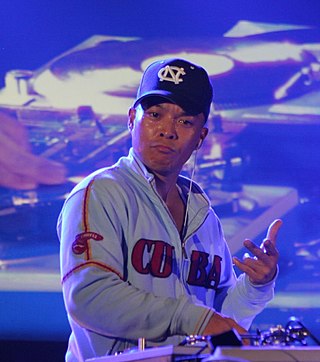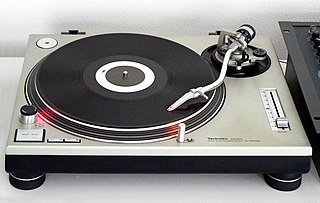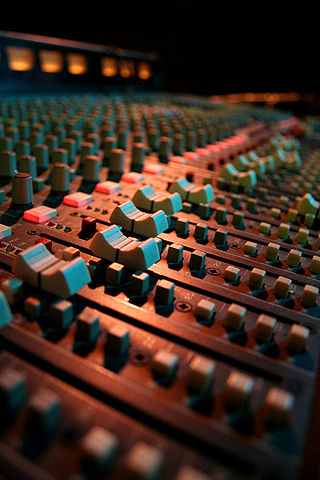
Beatmatching or pitch cue is a disc jockey technique of pitch shifting or timestretching an upcoming track to match its tempo to that of the currently playing track, and to adjust them such that the beats are synchronized—e.g. the kicks and snares in two house records hit at the same time when both records are played simultaneously. Beatmatching is a component of beatmixing which employs beatmatching combined with equalization, attention to phrasing and track selection in an attempt to make a single mix that flows together and has a good structure.

A disc jockey, more commonly abbreviated as DJ, is a person who plays recorded music for an audience. Types of DJs include radio DJs, club DJs, mobile DJs, and turntablists. Originally, the "disc" in "disc jockey" referred to shellac and later vinyl records, but nowadays DJ is used as an all-encompassing term to also describe persons who mix music from other recording media such as cassettes, CDs or digital audio files on a CDJ, controller, or even a laptop. DJs may adopt the title "DJ" in front of their real names, adopted pseudonyms, or stage names.
An audiophile is a person who is enthusiastic about high-fidelity sound reproduction. An audiophile seeks to reproduce the sound of a piece of recorded music or a live musical performance, typically inside closed headphones, In-ear monitors, open headphones in a quiet listening space, or a room with good acoustics.

A mixing console or mixing desk is an electronic device for mixing audio signals, used in sound recording and reproduction and sound reinforcement systems. Inputs to the console include microphones, signals from electric or electronic instruments, or recorded sounds. Mixers may control analog or digital signals. The modified signals are summed to produce the combined output signals, which can then be broadcast, amplified through a sound reinforcement system or recorded.

Scratching, sometimes referred to as scrubbing, is a DJ and turntablist technique of moving a vinyl record back and forth on a turntable to produce percussive or rhythmic sounds. A crossfader on a DJ mixer may be used to fade between two records simultaneously.

Turntablism is the art of manipulating sounds and creating new music, sound effects, mixes and other creative sounds and beats, typically by using two or more turntables and a cross fader-equipped DJ mixer. The mixer is plugged into a PA system and/or broadcasting equipment so that a wider audience can hear the turntablist's music. Turntablists atypically manipulate records on a turntable by moving the record with their hand to cue the stylus to exact points on a record, and by touching or moving the platter or record to stop, slow down, speed up or, spin the record backwards, or moving the turntable platter back and forth, all while using a DJ mixer's crossfader control and the mixer's gain and equalization controls to adjust the sound and level of each turntable. Turntablists typically use two or more turntables and headphones to cue up desired start points on different records.

Multitrack recording (MTR), also known as multitracking, is a method of sound recording developed in 1955 that allows for the separate recording of multiple sound sources or of sound sources recorded at different times to create a cohesive whole. Multitracking became possible in the mid-1950s when the idea of simultaneously recording different audio channels to separate discrete "tracks" on the same reel-to-reel tape was developed. A "track" was simply a different channel recorded to its own discrete area on the tape whereby their relative sequence of recorded events would be preserved, and playback would be simultaneous or synchronized.

A variable speed pitch control is a control on an audio device such as a turntable, tape recorder, or CD player that allows the operator to deviate from a standard speed, resulting in adjustments in pitch. The latter term "vari-speed" is more commonly used for tape decks, particularly in the UK. Analog pitch controls vary the voltage being used by the playback device; digital controls use digital signal processing to change the playback speed or pitch. A typical DJ deck allows the pitch to be increased or reduced by up to 8%, which is achieved by increasing or reducing the speed at which the platter rotates.

Technics SL-1200 is a series of direct-drive turntables originally manufactured from October 1972 until 2010, and resumed in 2016, by Matsushita Electric under the brand name of Technics. S means "Stereo", L means "Player". Originally released as a high fidelity consumer record player, it quickly became adopted among radio and disco club disc jockeys, thanks to the direct drive, high torque motor design, making it initially suitable for pushbutton cueing and starting of tracks on radio and in dance clubs. It is still extremely popular with audiophiles.
Voice-tracking, also called cyber jocking and referred to sometimes colloquially as a robojock, is a technique employed by some radio stations in radio broadcasting to produce the illusion of a live disc jockey or announcer sitting in the radio studios of the station when one is not actually present. It is one of the notable effects of radio homogenization.

In audio engineering, a fade is a gradual increase or decrease in the level of an audio signal. The term can also be used for film cinematography or theatre lighting in much the same way.

A DJ mixer is a type of audio mixing console used by disc jockeys (DJs) to control and manipulate multiple audio signals. Some DJs use the mixer to make seamless transitions from one song to another when they are playing records at a dance club. Hip hop DJs and turntablists use the DJ mixer to play record players like a musical instrument and create new sounds. DJs in the disco, house music, electronic dance music and other dance-oriented genres use the mixer to make smooth transitions between different sound recordings as they are playing. The sources are typically record turntables, compact cassettes, CDJs, or DJ software on a laptop. DJ mixers allow the DJ to use headphones to preview the next song before playing it to the audience. Most low- to mid-priced DJ mixers can only accommodate two turntables or CD players, but some mixers can accommodate up to four turntables or CD players. DJs and turntablists in hip hop music and nu metal use DJ mixers to create beats, loops and so-called scratching sound effects.

Vestax Corporation was a Japanese musical instrument, turntable and audio equipment firm founded by Hidesato Shiino in 1977. The company started by designing and manufacturing electronic guitars. In the 1980s, Vestax produced multitrack recorders and later moved to making DJ mixers, professional turntables, compact disc players and signal processors. Debt troubles led to the company's bankruptcy at the end of 2014.

Vinyl emulation allows a user to physically manipulate the playback of digital audio files on a computer using the turntables as an interface, thus preserving the hands-on control and feel of DJing with vinyl. This has the added advantage of using turntables to play back audio recordings not available in phonograph form. This method allows DJs to scratch, beatmatch, and perform other turntablism that would be impossible with a conventional keyboard-and-mouse computer interface or less tactile control devices.
Stanton Magnetics, doing business as Stanton, is a business unit of inMusic Brands that designs and markets turntables, cartridges, DJ mixers, DJ media players, and DJ controllers.
A DJ mix or DJ mixset is a sequence of musical tracks typically mixed together to appear as one continuous track. DJ mixes are usually performed using a DJ mixer and multiple sounds sources, such as turntables, CD players, digital audio players or computer sound cards, sometimes with the addition of samplers and effects units, although it is possible to create one using sound editing software.

A CDJ is a specialized digital music player for DJing. Originally designed to play music from compact discs, many CDJs can play digital music files stored on USB flash drives or SD cards. In typical use, at least two CDJs are plugged into a DJ mixer. CDJs have jog wheels and pitch faders that allow manipulation of the digital music similar to a vinyl record on a DJ turntable. Many have additional features such as loops and beat analysis that are not present on turntables. Additionally, some can function as DJ controllers to control the playback of digital files in DJ software running on a laptop instead of playing the files on the CDJ.

The LP is an analog sound storage medium, a phonograph record format characterized by: a speed of 33+1⁄3 rpm; a 12- or 10-inch diameter; use of the "microgroove" groove specification; and a vinyl composition disk. Introduced by Columbia in 1948, it was soon adopted as a new standard by the entire record industry. Apart from a few relatively minor refinements and the important later addition of stereophonic sound, it remained the standard format for record albums until its gradual replacement from the 1980s to the early 2000s, first by cassettes, then by compact discs, and finally by digital music distribution. Beginning in the late 2000s, the LP has experienced a resurgence in popularity.

DJ controllers are devices used to help DJs mix music with DJ software using knobs, encoders, jog wheels, faders, backlit buttons, touch strips, and other components.

DJing is the act of playing existing recorded music for a live audience.
















